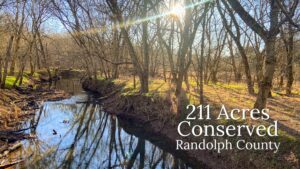
By Crystal Cockman
June 29,2016
A few years back, the NC Natural Heritage Program did an insect survey of the Uwharries. Insects are a good indicator of high quality habitats because they are often very specialized. They are also an indicator of well-integrated landscapes, because populations come and go and survival depends on being able to move between habitat units.
In the survey, several main habitat types were chosen including hillside seepage bogs, longleaf pine habitats, mesic forests, canebrakes, wet hardwood forests, dry woodlands, and basic forests. Species specific to these habitat types were looked for and found in many cases. In other cases these likely candidates were not located in the habitat types where they were expected.
 Eotettix pusillus are a cute little grasshopper. The nymphs have a red head and black legs, and adults are a yellow-green. They are also known as seepage grasshoppers, found in seeps and boggy areas. Unfortunately none were found in the survey areas of this study. Another species of grasshopper, Mermiria picta, are related to longleaf pine habitats, associated with shrub and ground cover. None of these were found in the study either.
Eotettix pusillus are a cute little grasshopper. The nymphs have a red head and black legs, and adults are a yellow-green. They are also known as seepage grasshoppers, found in seeps and boggy areas. Unfortunately none were found in the survey areas of this study. Another species of grasshopper, Mermiria picta, are related to longleaf pine habitats, associated with shrub and ground cover. None of these were found in the study either.
One species of grasshopper appeared to be Melanoplus hubbelli, though it needs some additional confirmation. They are a grasshopper that is a montane disjunct, which means they are mostly known from the mountains. They are a member of the spurthroat grasshoppers, and are a watch list species in North Carolina. Melanoplus is a large genus of grasshoppers, and the largest of this species reaches 2 inches in length.
 The dark-sided grasshopper, Melanoplus nigrescens, are found in dry woodlands and glades. They were the most widespread of the flightless grasshoppers in the Uwharries, and appear to be very scarce elsewhere in the state. They are also a watch list species in North Carolina. Its abundance in the Uwharries is indicative of the presence of both good quality habitats and an intact landscape, with many connections still linking habitat units together, at least for the drier ridgetop forests.
The dark-sided grasshopper, Melanoplus nigrescens, are found in dry woodlands and glades. They were the most widespread of the flightless grasshoppers in the Uwharries, and appear to be very scarce elsewhere in the state. They are also a watch list species in North Carolina. Its abundance in the Uwharries is indicative of the presence of both good quality habitats and an intact landscape, with many connections still linking habitat units together, at least for the drier ridgetop forests.
The results of the study identified 692 species. Of these, 37 were odonates (dragonflies and damselflies), 42 were orthopterans (grasshoppers, crickets, katydids, locusts), 60 were butterflies, and 519 were macromoths. Of these species, 7 were significantly rare, and 14 were watch list species. 75 were habitat or landscape indicator species.
 Ultimately, some of the insects that were expected to be found in specific habitat types were found and others were not. This does not mean it is too late to enhance habitats for these species. And benefits to insects are beneficial to the entire ecosystem. The best ways to protect these habitat indicator species are to target clusters of habitat units, conserve linking habitats between units, and restore units within the gaps.
Ultimately, some of the insects that were expected to be found in specific habitat types were found and others were not. This does not mean it is too late to enhance habitats for these species. And benefits to insects are beneficial to the entire ecosystem. The best ways to protect these habitat indicator species are to target clusters of habitat units, conserve linking habitats between units, and restore units within the gaps.